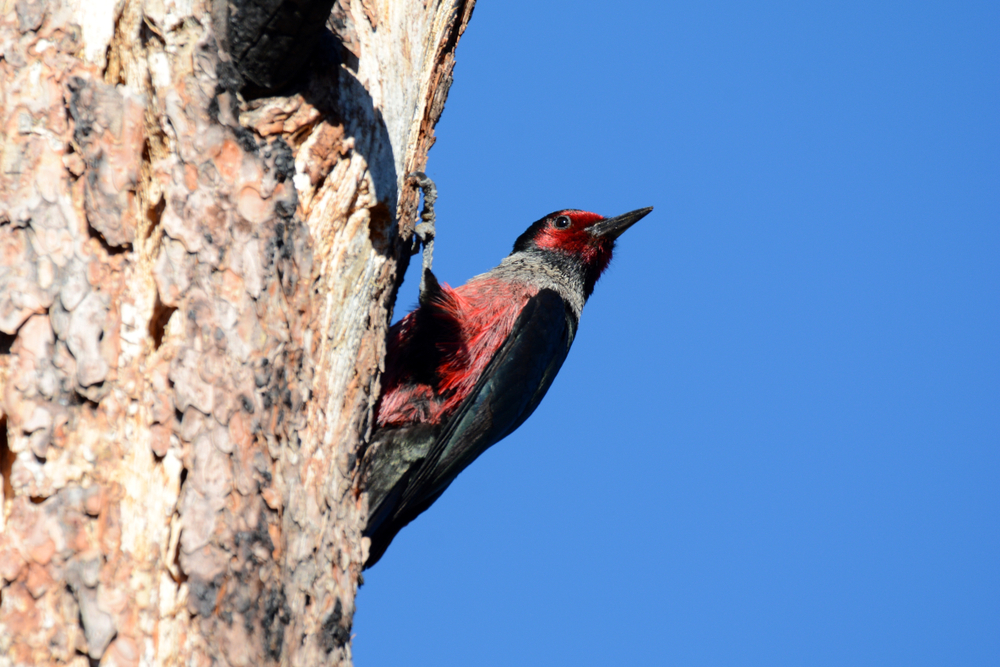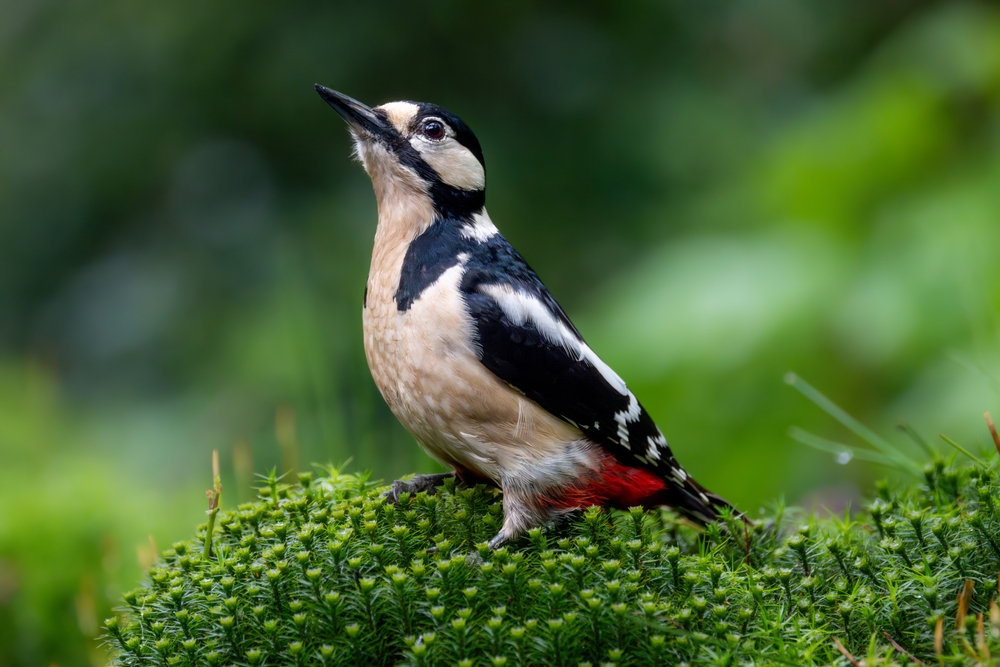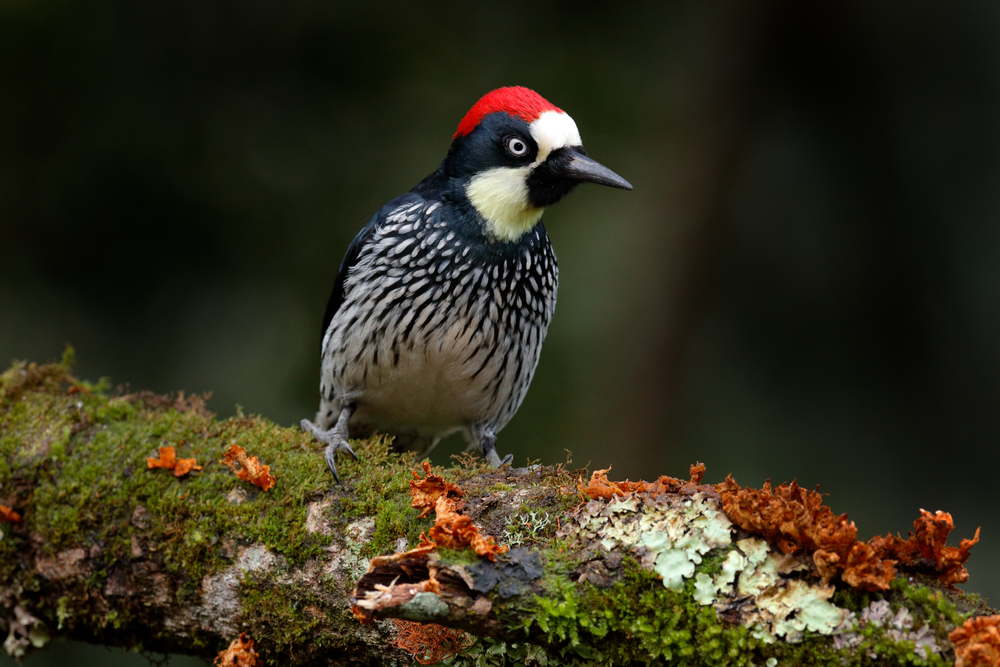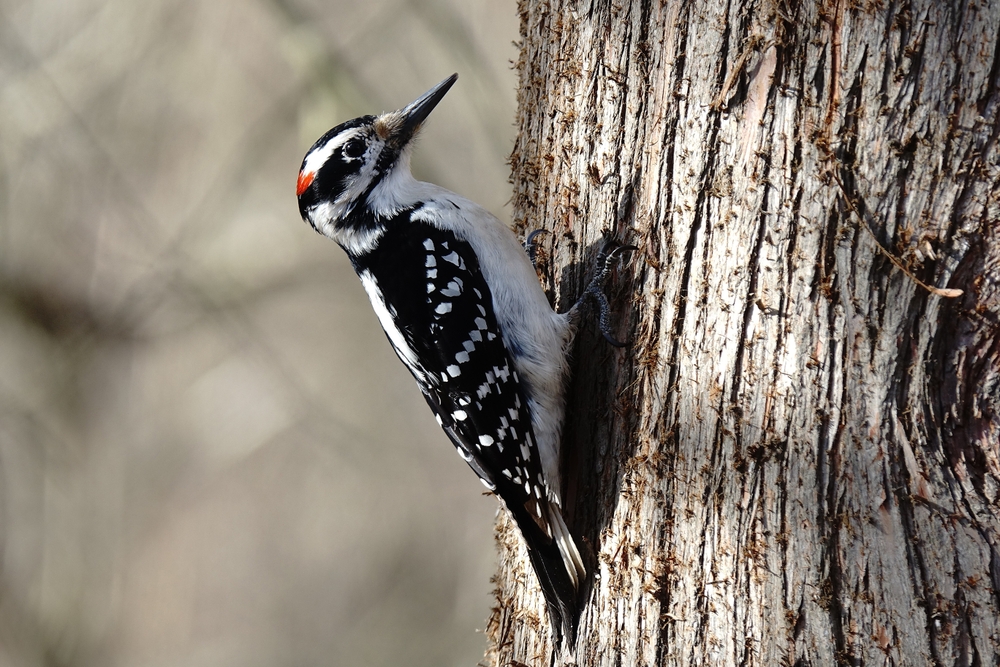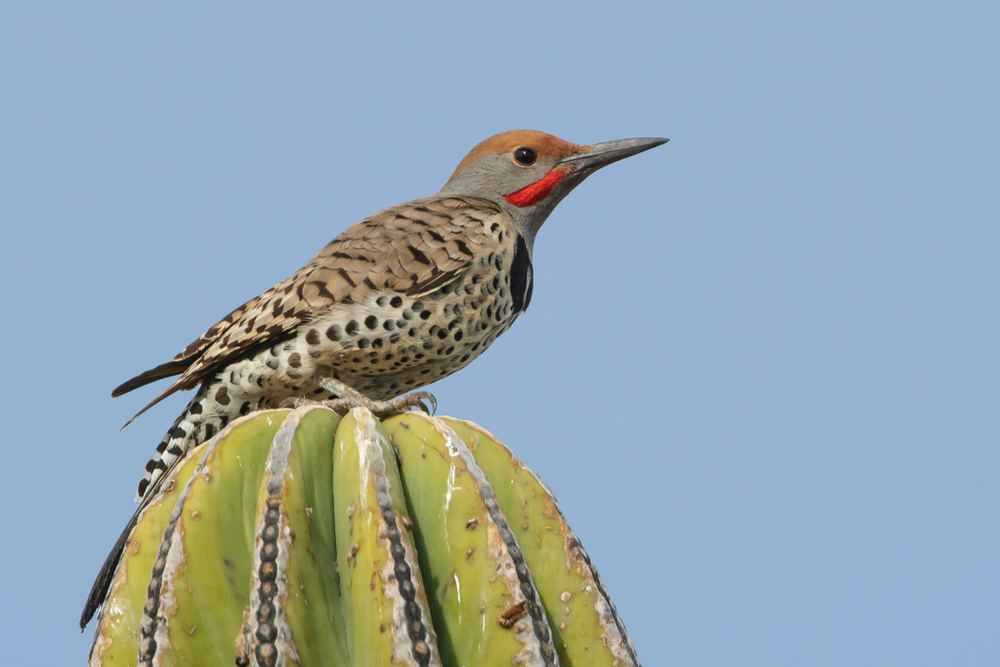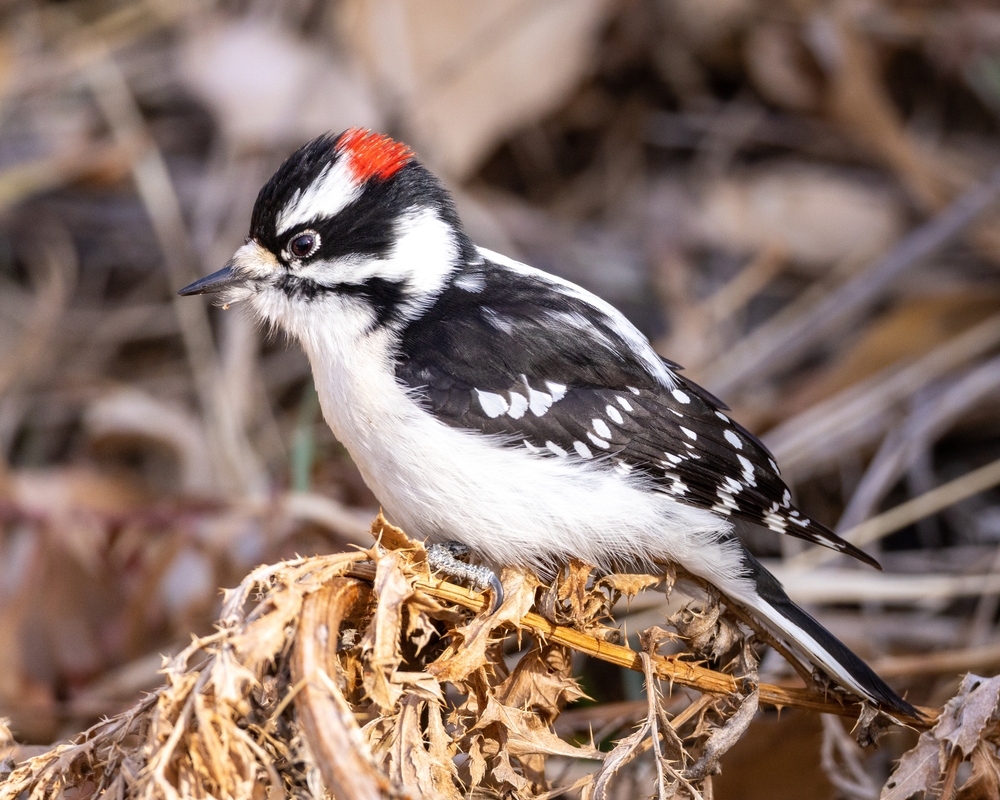The Lewis’s Woodpecker (Melanerpes lewis) belongs to the same genus as the Acorn Woodpecker (M. formicivorus) and the Red-headed Woodpecker (M. erythrocephalus). All share food-storing behavior and bold plumage, though the Lewis’s is unique in its crow-like flight and aerial insect hunting.
About
The Lewis’s Woodpecker (Melanerpes lewis), a member of the Picidae family, is a unique North American woodpecker named after explorer Meriwether Lewis of the Lewis and Clark Expedition. Unlike many of its relatives, it exhibits unusual behaviors and feeding strategies that make it stand out among woodpeckers. Found mainly in open pine forests, burned woodlands, and river groves of the western United States and parts of Canada, this species is both striking in appearance and fascinating in behavior.
Measuring 26–28 cm (10–11 in) in length with a wingspan of about 49 cm (19 in), Lewis’s Woodpecker has a distinctive look unlike most woodpeckers. Its plumage includes a dark greenish-black back, a pinkish-red belly, a gray collar, and a bold red face patch. Broad wings and a relatively slow, crow-like flight further distinguish it from its woodpecker relatives.
Unlike most woodpeckers that spend much of their time chiseling into wood for insects, Lewis’s Woodpecker is an aerial forager. It catches flying insects in midair with remarkable agility, often perching openly on snags before sallying out like a flycatcher. Its diet also includes acorns and other nuts, which it stores in crevices for winter, as well as fruits and berries.
Breeding usually takes place in cavities excavated in dead trees or snags, though this species will sometimes use natural cavities. Both parents share incubation of 5–9 eggs and care for the chicks, which fledge after about a month. Nest sites are often in open, fire-affected forests, highlighting the importance of natural disturbance to its ecology.
Although not considered globally threatened, Lewis’s Woodpecker faces declines in some areas due to habitat loss, fire suppression, and competition for nesting cavities. Conservation efforts emphasize the preservation of old-growth and burned forest habitats critical to its survival.
Physical Characteristics
The Lewis’s Woodpecker is a large, dark woodpecker of western North America, notable for its unusual coloration and graceful flight:
Head and Face:
They have a dark greenish-black head with a red face and throat. The contrasting pinkish-red facial patch is distinctive and one of the best field marks.
Beak:
The beak is straight, medium-length, and gray-black, well-suited for catching insects in flight as well as foraging on bark.
Plumage:
Their plumage is highly distinctive among woodpeckers: the back, wings, and tail are glossy greenish-black; the collar and upper chest are gray; and the belly is a deep rose-pink. The striking tri-color pattern makes them unmistakable.
Body and Build:
They have a stocky build with broad wings and a longer tail compared to many woodpeckers. Their wing structure allows for slow, crow-like flight, different from the bounding flight typical of most woodpeckers.
Size:
-
Length: 10 to 11 in (25 to 28 cm)
-
Wingspan: 19 to 20 in (48 to 51 cm)
-
Weight: 3.1 to 4.9 oz (88 to 138 g)
The Lewis’s Woodpecker’s dark, iridescent plumage, pink belly, and crow-like flight style set it apart from all other North American woodpeckers.
Reproduction
The reproductive cycle of the Lewis’s Woodpecker is adapted to open woodlands and areas with abundant dead trees for nesting:
1. Courtship and Pair Formation:
Courtship begins in spring, with aerial displays, chases, and calling. Once paired, Lewis’s Woodpeckers are monogamous for the breeding season, and some pairs may reunite in successive years.
2. Breeding Season:
Breeding typically occurs from May to July, though timing varies by latitude and food availability.
3. Nesting:
Pairs excavate nest cavities in dead or decaying trees, utility poles, or snags, often near open areas for foraging. Old cavities may also be reused. Nest sites are usually 10 to 60 ft (3 to 18 m) above the ground.
4. Egg Laying:
The female lays 5 to 9 white eggs, more than most woodpecker species.
5. Incubation:
Incubation lasts about 12 to 14 days, with both parents sharing duties. The male often incubates at night while the female takes the day shift.
6. Chick Development:
Chicks hatch altricial (naked and helpless) and are fed insects and other food items by both parents. Parents regurgitate food into the chicks’ mouths.
7. Fledging and Independence:
Young fledge at about 4 to 5 weeks of age and may remain dependent on parents for feeding for a short period after leaving the nest.
The Lewis’s Woodpecker’s relatively large clutch size and cooperative parenting help offset high predation risks on eggs and chicks in open woodland environments.
Lifespan
The Lewis’s Woodpecker is a long-lived bird compared to many small passerines, though its survival depends on stable woodland habitats and food availability.
Lifespan in the Wild:
In their natural habitats of open pine forests, riparian woodlands, and oak savannas, Lewis’s Woodpeckers typically live about 5 to 10 years, with the oldest recorded individuals reaching 11+ years.
Lifespan in Captivity:
When protected from predators and provided with steady food, they may live longer, though detailed captive longevity records are limited. Some individuals can surpass 12 years in managed care.
Threats to the Lewis’s Woodpecker:
-
Habitat Loss: Logging, fire suppression, and urban expansion reduce suitable nesting trees and open foraging habitats.
-
Predation: Eggs and chicks are vulnerable to snakes, raccoons, and other birds such as starlings that also compete for cavities.
-
Competition: They often compete with European Starlings and other cavity nesters for nesting sites.
-
Climate Change: Shifts in insect availability and tree cover may affect their survival and reproduction.
Despite these challenges, Lewis’s Woodpeckers remain locally common in areas with abundant dead trees for nesting and open ground for aerial insect hunting.
Eating Habits
The Lewis’s Woodpecker has feeding habits that are highly unusual among woodpeckers, relying more on aerial foraging than drilling into trees:
Diet:
Their diet is diverse and seasonal. Insects form the bulk of their food in spring and summer, while fruits, berries, and nuts—especially acorns—become important in fall and winter.
Feeding Strategy:
Unlike most woodpeckers, Lewis’s Woodpeckers frequently catch insects in midair, using graceful, crow-like flight. They also glean insects from tree bark and ground surfaces. In autumn, they store acorns and other nuts in tree crevices for later use.
Role in Ecosystem:
By feeding heavily on flying insects, they reduce populations of pest species. Their habit of storing nuts also contributes to seed dispersal in woodlands.
Social Feeding Behavior:
They are more social than many woodpeckers, often foraging in loose groups and sharing abundant food sources such as insect swarms or fruiting trees.
Feeding Technique:
They sally out from perches to snatch flying insects, much like a flycatcher. They also use their strong bill to wedge acorns into crevices, hammering them in tightly for long-term storage.
The Lewis’s Woodpecker’s aerial hunting style, combined with its food-storing behavior, makes it one of the most unique and specialized woodpeckers in North America.
Uniqueness
The Lewis’s Woodpecker (Melanerpes lewis) is one of the most distinctive woodpeckers in North America, both in appearance and behavior:
Unusual Plumage:
Unlike the typical black-and-white patterns of most woodpeckers, Lewis’s Woodpeckers display a glossy greenish-black back, gray collar, red face, and pink belly, making them unmistakable.
Aerial Foraging:
They are unique among woodpeckers for catching insects in flight, using slow, crow-like wingbeats instead of the bounding flight typical of other woodpeckers.
Food Storage Behavior:
Like Acorn Woodpeckers, they store nuts—especially acorns—by wedging them into tree crevices, creating caches to rely on during lean months.
Quiet Nature:
They drum less often than most woodpeckers and are relatively silent compared to other species, making them less conspicuous despite their bold appearance.
Habitat Specialist:
They thrive in open pine forests, oak savannas, and burned woodlands where standing dead trees provide nesting sites and open ground offers foraging opportunities.
Namesake:
They are named after the famous explorer Meriwether Lewis of the Lewis and Clark Expedition, who first documented the species in the early 19th century.
The Lewis’s Woodpecker’s striking coloration, flycatcher-like foraging, and acorn-storing behavior make it one of the most unusual and fascinating members of the woodpecker family.
Be the First to Share Photos of This Species.
FAQ’s
1. What species is closest to the Lewis’s Woodpecker?
2. How does the Lewis’s Woodpecker compare to other woodpeckers?
Unlike most woodpeckers that drill into bark, the Lewis’s Woodpecker feeds like a flycatcher, catching insects in flight. It also stores acorns like the Acorn Woodpecker, but with less communal behavior. Its dark, iridescent plumage and pink belly also make it stand out from the typically black-and-white patterned woodpeckers.
3. What national parks provide the best opportunity to see a Lewis’s Woodpecker?
Lewis’s Woodpeckers are found in open woodlands of western North America. Some of the best national parks to see them include:
-
Yellowstone National Park, USA
-
Rocky Mountain National Park, USA
-
Crater Lake National Park, USA
-
Glacier National Park, USA
-
Yosemite National Park, USA
These parks provide ideal habitats with pine forests, oak savannas, and post-burn landscapes that attract Lewis’s Woodpeckers.



































































